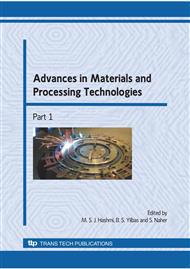p.718
p.725
p.738
p.746
p.756
p.764
p.771
p.777
p.785
A Study of Machining Parameters during Electrical Discharge Machining of Steel by a Rotary Copper Electrode
Abstract:
The use of thermo-electric source of energy, as in electrical discharge machining (EDM), has greatly helped in machining all types of electrically conductive materials being used in different industrial applications. The present work investigates the different machining characteristics during electrical discharge machining on EN-8 steel with a rotary copper electrode. The effects of three independent machining parameters viz. peak current, pulse on time and rotational speed of tool electrode are chosen as variables for evaluating the output parameters such as metal removal rate, surface finish of work piece. The research focuses on developing empirical models for prediction of metal removal rate and surface finish during rotary electrical discharge machining process with the help of input parameters. The models are developed using linear regression analysis by applying logarithmic data transformation of non-linear equation. Analysis of results using partial and multiple correlation analysis reveals that electrical parameters have more significant effect than the non-electrical parameters on the machining characteristics during electrical discharge machining by a rotary electrode. Furthermore, when high MRR is criterion, high peak current and low RPM with low pulse duration produces better output; whereas, and when smooth surface finish is criterion, low peak current and low RPM with high pulse duration produces better output. In addition, the predictions based on the above developed models are verified with extra experiments and are found to be in good agreement with the experimental verifications.
Info:
Periodical:
Pages:
756-763
Citation:
Online since:
December 2009
Authors:
Keywords:
Price:
Сopyright:
© 2010 Trans Tech Publications Ltd. All Rights Reserved
Share:
Citation:


